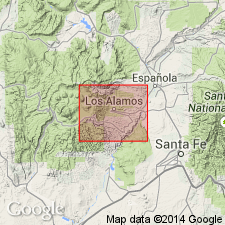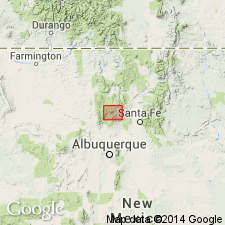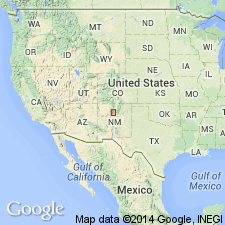
- Usage in publication:
-
- Tewa Group*
- Modifications:
-
- Original reference
- Dominant lithology:
-
- Tuff
- Rhyolite
- Quartz latite
- AAPG geologic province:
-
- San Juan basin
Summary:
Pg. 18 (fig. 8), 45-59. Tewa Group. Name given to rhyolite tuff and the rhyolite and quartz latite domes that constitute the latest eruptive rocks of Jemez Mountains volcanic pile. In Los Alamos area, north-central New Mexico, includes Bandelier Tuff, Cerro Toledo Rhyolite (new), Cerro Rubio Quartz Latite (new), and Valles Rhyolite (new). Age is Pleistocene.
Area has no distinctive physiographic feature from which to take a name for group. Name Tewa (after Indian tribe of area and by whose name the surrounding mountains were once known) was chosen.
Source: US geologic names lexicon (USGS Bull. 1350, p. 754).

- Usage in publication:
-
- Tewa Group
- Modifications:
-
- Geochronologic dating
- Paleomagnetics
- AAPG geologic province:
-
- San Juan basin
Summary:
Informal upper and lower members of Bandelier Tuff (following usage of Smith and Bailey, 1966) dated by K-Ar method on anorthoclase and sanidine samples taken in Valles caldera, Jemez Mountains, Sandoval Co, NM in San Juan basin. [Bandelier recognized as a member of Tewa Group--author did not state this, however.] Lower member--Otowi and underlying Guaje Members of Griggs (1964)--dated on sanidine as 1.4 m.y. old. Upper member--Tshirege Member of Griggs (1964)--dated on anorthoclase and sanidine as 1.0 m.y. old. Has reversed magnetic polarity. Is of early Pleistocene age.
Source: GNU records (USGS DDS-6; Denver GNULEX).

- Usage in publication:
-
- Tewa Group*
- Modifications:
-
- Revised
- AAPG geologic province:
-
- San Juan basin
Summary:
Lower contact of Tewa Group revised in Jemez Mountains, Sandoval, Los Alamos, Rio Arriba, and Santa Fe Cos, north-central NM--unconformably overlies both 1) Polvadera Group (new), which is divided into (ascending): Lobato Basalt (new), Tschicoma Formation, and El Rechuelos Rhyolite (new); and 2) Keres Group (new), which is divided into (ascending): Basalt of Chamisa Mesa, Canovas Canyon Rhyolite (new), Paliza Canyon Formation (new), and Bearhead Rhyolite, which is further subdivided into a tuffaceous facies, Peralta Tuff Member (both new). Polvadera Group is of middle to late Pliocene age. Keres Group is of early to middle Pliocene age. Tewa Group is Pleistocene age.
Source: GNU records (USGS DDS-6; Denver GNULEX).
For more information, please contact Nancy Stamm, Geologic Names Committee Secretary.
Asterisk (*) indicates published by U.S. Geological Survey authors.
"No current usage" (†) implies that a name has been abandoned or has fallen into disuse. Former usage and, if known, replacement name given in parentheses ( ).
Slash (/) indicates name conflicts with nomenclatural guidelines (CSN, 1933; ACSN, 1961, 1970; NACSN, 1983, 2005, 2021). May be explained within brackets ([ ]).

